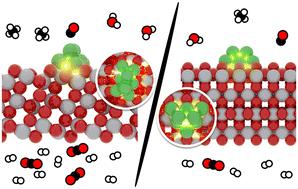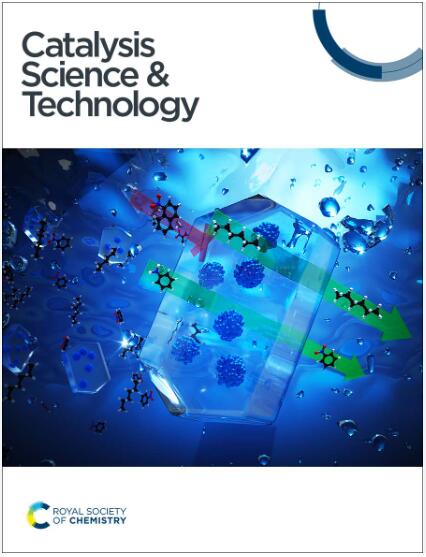TiO2支撑的Ni8团簇的二氧化碳氢化多尺度建模:锐钛型和金红石型多晶体的影响†。
IF 4.4
3区 化学
Q2 CHEMISTRY, PHYSICAL
引用次数: 0
摘要
选择何种二氧化钛相(锐钛相或金红石相)来支持小镍簇,会极大地影响二氧化碳加氢制甲烷的活性和选择性。为了模拟和理解这些差异,我们开发了一个分层多尺度催化模型。利用遗传算法和密度泛函理论相结合的混合方法,我们确定了支撑在锐钛矿(Ni8/TiO2-a)和金红石(Ni8/TiO2-r)上的 Ni8 团簇的推定全局最小结构,它们在形态上是不同的。基于 DFT 计算得出的这些不同团簇的能量学的微动力学模拟揭示了 CO2 加氢为 CO、CH4 和 CH3OH 的机理。在 Ni8/TiO2-a 和 Ni8/TiO2-r 上,CH4 是低温下的主要产物,而随着温度的升高会转变为 CO。与 Ni8/TiO2-r 相比,Ni8/TiO2-a 表现出更高的活性,并随着温度的升高对 CH4 保持更高的选择性。通过灵敏度分析,我们确定了导致观察到的选择性差异的步骤,并通过详细的电子结构分析,合理解释了观察到的不同团簇之间这些步骤的势垒差异。本文章由计算机程序翻译,如有差异,请以英文原文为准。

Multiscale modelling of CO2 hydrogenation of TiO2-supported Ni8 clusters: on the influence of anatase and rutile polymorphs†
The selection of TiO2 phase, whether anatase or rutile, for supporting small Ni clusters significantly influences the activity and selectivity in CO2 hydrogenation to methane. To model and understand these variances, we developed a hierarchical multiscale catalytic model. Utilizing a hybrid approach combining genetic algorithms and density functional theory, we identified the putative global minimum structures of Ni8 clusters supported on anatase (Ni8/TiO2-a) and rutile (Ni8/TiO2-r), which are morphologically distinct. Microkinetics simulations based on the energetics derived from DFT calculations over these distinct clusters reveal the mechanism of CO2 hydrogenation to CO, CH4 and CH3OH. On both Ni8/TiO2-a and Ni8/TiO2-r, CH4 is the main product at low temperature while a shift to CO occurs with increasing temperature. In comparison to Ni8/TiO2-r, Ni8/TiO2-a exhibits a higher activity and keeps a higher selectivity towards CH4 with increasing temperature. Using a sensitivity analysis, we identify the steps responsible for the observed selectivity difference and rationalize the observed barrier differences for these steps between the different clusters by means of detailed electronic structure analysis.
求助全文
通过发布文献求助,成功后即可免费获取论文全文。
去求助
来源期刊

Catalysis Science & Technology
CHEMISTRY, PHYSICAL-
CiteScore
8.70
自引率
6.00%
发文量
587
审稿时长
1.5 months
期刊介绍:
A multidisciplinary journal focusing on cutting edge research across all fundamental science and technological aspects of catalysis.
Editor-in-chief: Bert Weckhuysen
Impact factor: 5.0
Time to first decision (peer reviewed only): 31 days
 求助内容:
求助内容: 应助结果提醒方式:
应助结果提醒方式:


